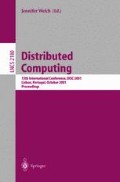Abstract
Self-stabilizing algorithms for constructing a spanning tree of an arbitrary network have been studied for many models of distributed networks including those that communicate via registers (either composite or read/write atomic) and those that employ message-passing. In contrast, much less has been done for the corresponding minimum spanning tree problem. The one published self-stabilizing distributed algorithm for the minimum spanning problem that we are aware of [3] assumes a composite atomicity model. This paper presents two minimum spanning tree algorithms designed directly for deterministic, message-passing networks. The first converts an arbitrary spanning tree to a minimum one; the second is a fully self-stabilizing construction. The algorithms assume distinct identifiers and reliable fifo message passing, but do not rely on a root or synchrony. Also, processors have a safe time-out mechanism (the minimum assumption necessary for a solution to exist.) Both algorithms apply to networks that can change dynamically.
Access this chapter
Tax calculation will be finalised at checkout
Purchases are for personal use only
Preview
Unable to display preview. Download preview PDF.
References
Aggarwal, S., Kutten, S.: Time Optimal Self-Stabilizing Spanning Tree Algorithm. In FSTTCS93 Proceedings of the 13th Conference on Foundations of Software Technology and Theoretical Computer Science, Lecture Notes in Computer Science, Vol. 761. Springer-Verlag, (1993) 400–410
Antonoiu, G., Srimani, P.K.: A Self-Stabilizing Distributed Algorithm to Construct an Arbitrary Spanning Tree of a Connected Graph. Computers and Mathematics with Applications 30 (1995) 1–7
Antonoiu, G., Srimani, P.: Distributed Self-Stabilizing Algorithm for Minimum Spanning Tree Construction. Euro-par’97 Parallel Processing, Lecture Notes in Computer Science, Vol. 1300. Springer-Verlag, (1997) 480–487
Arora, A., Nesterenko, M.: Stabilization-Preserving Atomicity Refinement. Proceedings of DISC’99, Lecture Notes in Computer Science, Springer-Verlag, (1999) 254–268
Atallah, M.J.: Algorithms and Theory of Computation Handbook. CRC Press LLC (1999)
Beauquier, J., Datta, A.K., Gradinariu, M., Magniette, F.: Self-Stabilizing Local Mutual Exclusion and Daemon Refinement. Proceedings of DISC’00, Lecture Notes in Computer Science, Springer-Verlag, (2000) 223–237
Chen, N.S., Yu, H.P., Huang, S.T.: A Self-Stabilizing Algorithm for Constructing Spanning Trees. Information Processing Letters 39 (1991) 147–151
Dijkstra, E.W.: Self Stabilizing Systems in Spite of Distributed Control. Communications of the Association of the Computing Machinery 17 (1974) 643–644
Dolev, S., Israeli, A., Moran, S.: Self-Stabilization of Dynamic Systems Assuming Only Read/Write Atomicity. Distributed Computing 7 (1993) 3–16
Dolev, S.: Self-Stabilization. MIT Press, Cambridge (Massachusetts) London (2000)
Gallager, R., Humblet, P., Spira, P.: A Distributed Algorithm for MinimumWeight Spanning Trees. ACM Trans. on Prog. Lang. and Systems 5:1 (1983) 66–77
Gouda, M.G., Multari, N.: Stabilizing Communication Protocols. IEEE Trans. on Computers 40 (1991) 448–458
Huang, S.T., Chen, N.S.: A Self-Stabilizing Algorithm for Constructing Breadth-First Trees. Information Processing Letters 41 (1992) 109–117
Liang, Z.: Self-Stabilizing Minimum Spanning Trees. Technical Report UofC/TR/TR-2001-688-11, University of Calgary, Department of Computer Science (2001)
Sur, S., Srimani, P.K.: A Self-Stabilizing Distributed Algorithm for BFS Spanning Trees of a Symmetric Graph. Parallel Processing Letters 2 (1992) 171–179
Author information
Authors and Affiliations
Editor information
Editors and Affiliations
Rights and permissions
Copyright information
© 2001 Springer-Verlag Berlin Heidelberg
About this paper
Cite this paper
Higham, L., Liang, Z. (2001). Self-stabilizing Minimum Spanning Tree Construction on Message-Passing Networks. In: Welch, J. (eds) Distributed Computing. DISC 2001. Lecture Notes in Computer Science, vol 2180. Springer, Berlin, Heidelberg. https://doi.org/10.1007/3-540-45414-4_14
Download citation
DOI: https://doi.org/10.1007/3-540-45414-4_14
Published:
Publisher Name: Springer, Berlin, Heidelberg
Print ISBN: 978-3-540-42605-9
Online ISBN: 978-3-540-45414-4
eBook Packages: Springer Book Archive

